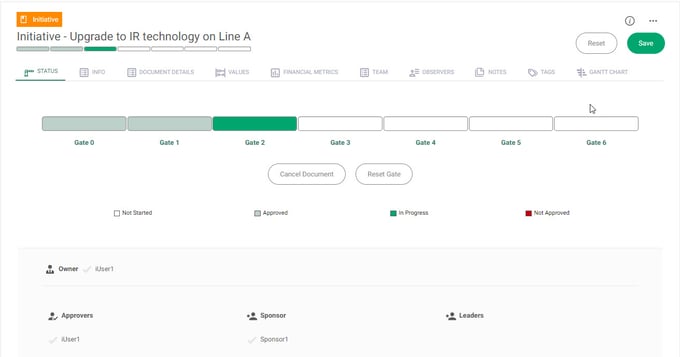Effective strategic initiative planning is crucial for organizations to achieve their goals and stay ahead of the competition. However, according to Gartner, only 8% of strategy leaders report a success rate of 90% or more on long-term strategic initiatives. That unacceptable level of failure is why strategic initiatives require careful consideration and planning. It's also why we developed our innovation performance management solution, InnoMetrix. In this post, we explore three essential aspects of strategic initiative planning: allocating human resources, planning financial investments, and employing a gated approval process.
- Allocating Human Resources:
The most valuable resource within any organization is its human capital. Allocating human resources effectively is vital for successful initiative planning. Here are some key steps to consider:
a) Define Roles and Responsibilities: Clearly identify the key individuals or teams responsible for executing each aspect of the strategic initiative. This ensures accountability and allows for better coordination.
b) Assess Competencies: Evaluate the skills and expertise of your existing workforce to determine if any gaps need to be filled. Consider training or hiring additional staff to ensure you have the right people in the right positions.
c) Balance Workloads: Distribute tasks and responsibilities evenly among team members to prevent burnout and maximize productivity. Remember that team members may have to dedicate time to day-to-day responsibilities so make sure they are not overcommitted.
d) Communication and Collaboration: Foster a culture of open communication and collaboration. Encourage adequate meetings, provide necessary resources, and promote cross-functional collaboration to enhance the effectiveness of the initiative.
e) Equip your team with the right tools: Many organizations struggle to manage strategic initiatives due to a mishmash of tools like spreadsheets, Slack channels, Word documents, and PowerPoints. Unfortunately, this results in fragmented data, hidden errors, version control issues, and scalability challenges. To overcome these obstacles, consider adopting a purpose-built, cloud-based solution that enables seamless planning, management, and collaboration on your strategic initiatives.

2. Planning Financial Investments:
Strategic initiatives often require financial investments to drive progress and achieve desired outcomes. Here's how to plan and manage financial investments effectively:
a) Define the Budget: Determine the financial resources available for the strategic initiative. Create a detailed budget that outlines the expected costs for various activities, such as research and development, marketing, technology investments, and talent acquisition.
b) Prioritize Investments: Identify the critical areas that require immediate financial support. Allocate funds based on the potential impact and Internal Rate of Return (IRR), Payback (and Months to Payback), or Net Present Value (NPV) for each aspect of the initiative. InnoMetrix automatically calculates these financial metrics for you.
c) Monitor and Evaluate: Regularly monitor financial performance and compare it against the planned budget. Implement mechanisms to track expenses, identify variances, and make adjustments as necessary.
d) Risk Management: Assess potential financial risks and develop contingency plans to mitigate them. Consider setting aside reserves or establishing risk-sharing mechanisms to protect against unforeseen challenges.
3. Employ a Gated Approval Process:
A “gated” approval process (also known as stage-gate or phase-gate) ensures that strategic initiatives progress through defined stages with clear objectives and deliverables. A gate is simply a checkpoint where approval(s) is required in order to proceed to the next stage. This approach enables better decision-making and mitigates risks. Here's a framework to establish a gated approval process:
a) Gate Framework: Break the strategic initiative into distinct stages or milestones, each with specific goals and deliverables. These gates act as decision points where the progress is evaluated, and the initiative moves forward, pivots, or terminates.
b) Cross-functional Review: At each gate, involve key stakeholders from different departments or areas of expertise. Their insights and expertise can provide a comprehensive view and improve decision-making.
c) Evaluation Criteria: Define specific evaluation criteria for each gate that align with the goals of the strategic initiative. This could include factors like financial viability, market potential, technical feasibility, and resource availability.
d) Gate Reviews: Conduct gate reviews to evaluate the progress made, assess risks and benefits, and determine whether the initiative should proceed to the next gate. These reviews ensure that resources are allocated effectively, and strategic objectives are met.

Strategic initiative planning is a multifaceted process that requires careful consideration of resource allocation, financial planning, and decision-making. By effectively allocating human resources, planning financial investments, and employing a gated approval process, organizations can enhance their chances of success. Remember, strategic initiatives are dynamic endeavors, and continuous monitoring, evaluation, and adaptation are crucial for long-term achievement.